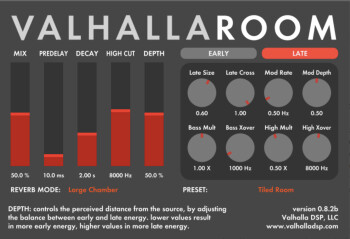This week we'll finish our overview of the different reverb families addressing the biggest one among them: rooms.
Get a room
As their name implies, room reverbs try to reproduce the sound of a recording made in a given room as naturally as possible. As a general rule, they are small-sized spaces whose reverb time is relatively short, from roughly 0.2 to 1 second. Given their nature, the separation between early reflections and diffused sound field is much more prominent with rooms, than with other types of reverb. Furthermore, they provide a very distinct coloration depending on the type of room simulated. On the other hand, they can be considered “fast” reverbs, which can have some advantages because they will not swamp the mix.

Due to their natural character, rooms are ideal when it comes to recreating a realistic three-dimensional space coherent for all elements of a mix. They are also commonly used to conceal the small defects present in close-miked acoustic takes, or to make DI recordings of synths, bass and acoustic-electric guitars, etc. more lively. Virtual instruments can obviously benefit from this type of reverb, too. At the same time, the"swiftness" of room reverbs makes them a particularly good match for percussive instruments, providing a nice and realistic sense of space, without interfering with the groove itself, regardless of how frenetic it is.
As I mentioned in the intro, the room family is pretty big, which can have its downs, too, considering that not all Rooms are the same. First of all, the algorithms are very complex and, hence, pretty hard to get right. As a consequence, the rooms of a plug-in can differ quite a bit from those of another one and a poor quality room can do more harm than good to your mix. So you need be careful in this respect and, in case you are not sure as to whether this or that plug-in is good enough, read user reviews and ask other people who know better ─ you will surely be able to find good advice right here in the Audiofanzine forums!
Another thing to consider is that, given their nature, the frequency response of rooms is far from being flat. In fact, the reverberation of any room has dips and bumps across the entire spectrum. So reproducing this behavior adds to the realism of the algorithms. However, a given reverb might not be the best match for a specific instrument. So make sure to choose the best room for the source in question. Unfortunately, there are no rules in this regard. A room that works wonders on a Strat coupled with a Marshall amp might sound completely awkward when applied to a Telecaster played through a Fender amp. But this is something you’ll have to learn and judge for yourself.
Finally, using too much of a room will make an instrument move to the back of the mix while making it sound tiny. Fortunately, you can solve this adjusting the pre-delay setting and/or EQing the reverb itself. But that’s something I’ll come to another day…


